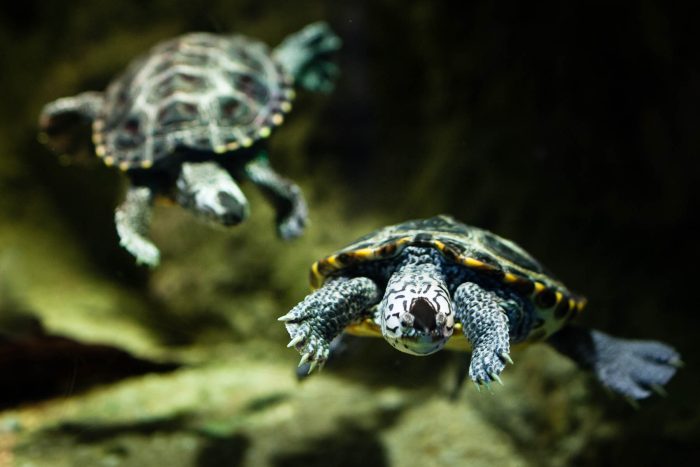Diamondback Terrapin
Malaclemys terrapin
The diamondback terrapin is an aquatic turtle with distinctive diamond-shaped rings covering its shell. It lives in and around the Chesapeake Bay’s brackish tidal waters, including rivers and marshes.
This section shows one large critter image at a time. Use the thumbnails that follow to select a specific image to display here.

This gallery contains a grid of small thumbnails. Selecting a thumbnail will change the main image in the preceding section.
Appearance
The carapace (shell) of the diamondback terrapin varies in color from brownish or greenish to grayish or nearly black. Their scaly, gray or whitish skin is covered with black spots or streaks. The carapace is covered with scutes (plates) that have diamond-shaped concentric growth rings inside; the growth rings may be a different color than the rest of the shell.
The plastron, or underside of the shell, is yellowish or greenish in color. Terrapins have a horned beak with a black "moustache" above the mouth and webbed feet with strong claws. They grow up to 9 inches in length, with females significantly larger than males.
Feeding
While terrapins feed mostly on mollusks, including clams, snails and mussels, they will also eat fish, worms, insects and crustaceans.
Reproduction and life cycle
Diamondback terrapins mate in the water, usually during nighttime in May. After mating, females come up onto beaches and dig a shallow nest in the sand. They lay 10 to 15 pinkish-white eggs. Females may lay several clutches in one breeding season. Eggs hatch in 60 to 100 days.
Like most turtle species, temperature determines the gender of the hatchlings: the warmer the nest, the more female terrapins develop. If hatchlings do not emerge by the onset of cold weather, they may overwinter in the sand and hatch the following spring.
Terrapins can live for 25 years in the wild, but they face many threats including predation, habitat loss, boat propellers and entrapment in crab pots.
Did you know?
- Diamondback terrapins are the official state reptile of Maryland.
- They are believed to be the only turtle in the world that lives exclusively in brackish water.
- The word “terrapin” comes from an Algonquin word for edible turtles that live in brackish water.
- You can determine a terrapin’s age by counting the growth rings on its scutes.
- A terrapin’s scutes are unique to each animals, just like fingerprints are to humans.
- Terrapin populations were decimated in the 18th and 19th centuries due to the popularity of terrapin soup. Many regulations now exist to protect terrapins.
Sources and additional information
- Life in the Chesapeake Bay by Alice Jane Lippson and Robert L. Lippson
- Chesapeake Bay: Nature of the Estuary, A Field Guide by Christopher P. White
- Field Guide to Maryland’s Turtles: Northern Diamondback Terrapin – Maryland Department of Natural Resources
- Animal Diversity Web: Malaclemys terrapin – University of Michigan Museum of Zoology
